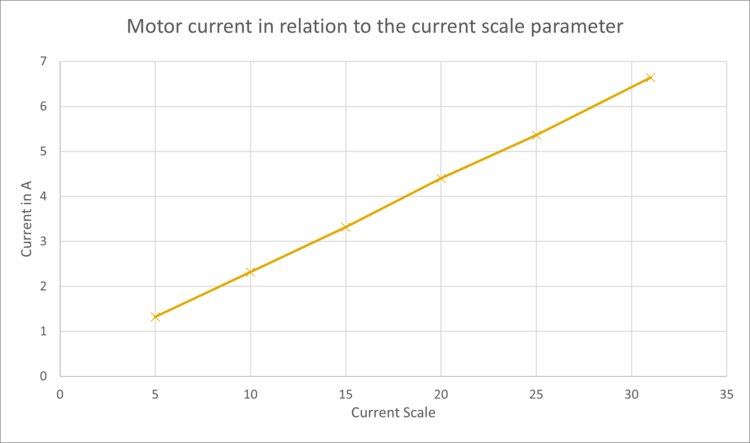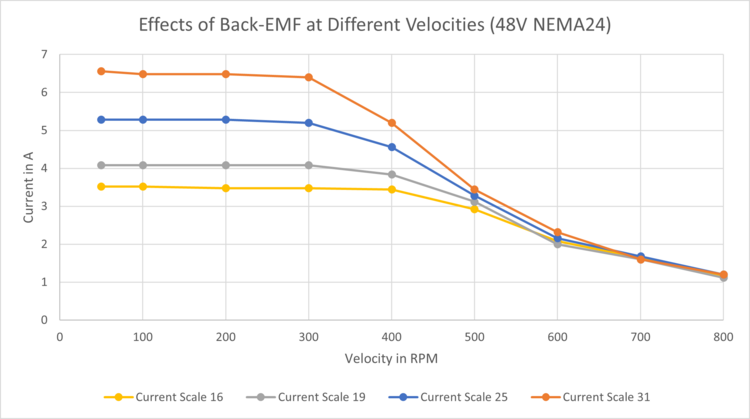Motor Current Parameter
The motor current of stepper motors can be adapted to the requirements of each axis via the current scale parameters in the Firmware Parameter Configuration. The most important factors are required torque, motor size and generated heat: If the current is set too high or if the motor does too few cooling breaks with lower current the motor and electronics can overheat and get damaged.
The following current parameters can be configured:
- CSLoad: current scale under load conditions
- CSStart: current scale at start of motion
- CSIdle: current scale when not moving
- CSRef: current scale when referencing
IMPORTANT: Do a stress test (e.g. 1hr) after changing the current scale parameter and watch the temperature at the motor. Since the motors do not have temperature sensors the electronics only monitors the temperatures of the electronic modules.
Current Scale and Actual Current
The current scale parameter is a number 1-31 that translates to a current as the following measurements show. This is independent from motor size and voltage.

| Current Scale | Actual Current (A) | Current Scale | Actual Current (A) |
|---|---|---|---|
| 1 | 0.5 | 16 | 3.6 |
| 2 | 0.7 | 17 | 3.8 |
| 3 | 0.9 | 18 | 4.0 |
| 4 | 1.1 | 19 | 4.2 |
| 5 | 1.3 | 20 | 4.4 |
| 6 | 1.5 | 21 | 4.6 |
| 7 | 1.7 | 22 | 4.8 |
| 8 | 1.9 | 23 | 5.0 |
| 9 | 2.1 | 24 | 5.2 |
| 10 | 2.3 | 25 | 5.4 |
| 11 | 2.5 | 26 | 5.6 |
| 12 | 2.7 | 27 | 5.8 |
| 13 | 2.9 | 28 | 6.0 |
| 14 | 3.1 | 29 | 6.2 |
| 15 | 3.3 | 30 | 6.4 |
| 31 | 6.6 |
Recommended Current Scale
We recommend the following values for the different motor types:
| Motor | Current Scale | Actual Current |
|---|---|---|
| NEMA17 | 8 | 1.9A |
| NEMA24 | 19 | 4.2A |
Examples:
| Robot Type | Motor | Voltage | Current Scale | Actual Current |
|---|---|---|---|---|
| DLE-RG-0014 | NEMA24 | 24V | 25 | 5.4A |
| 48V | 16 | 3.6A | ||
| NEMA23 | 24V | 22 | 4.8A | |
| 48V | 15 | 3.3A | ||
| NEMA17 | 24V | 12 | 2.7A | |
| 48V | 6 | 1.5A | ||
| DLE-RG-0374 | NEMA23 | 24V | 25 | 5.4A |
| 48V | 16 | 3.6A |
Torque Loss at High Velocities
The available torque of stepper motors decreases after a certain speed. This is an effect of Back EMF: the motor induces a current that is opposed to the current that turns the motor. The following diagram shows this effect; the usable current drops after 300 RPM. In practice this can cause issues like motor stalls at the fastest part of a motion.
These effects are considered in construction where motors and gears are chosen for the appropriate speed range. It also is a relevant factor for choosing the motor voltage of the system: 48V systems get more energy and (thereby torque) into the motors before back EMF becomes relevant than 24V systems.
